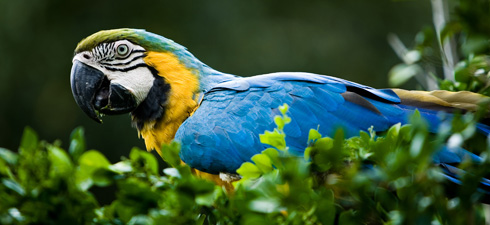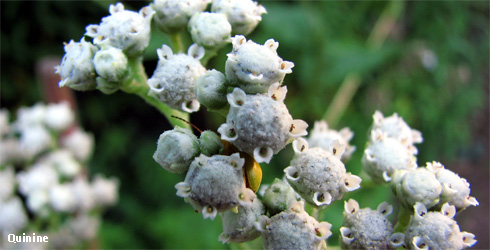Rain Forest Tour
-

The Animals
The warm, moist environment is an ideal habitat for reptiles and amphibians. Frogs, salamanders, snakes, and lizards are abundant. Visitors usually see the frogs and the iguanas and other lizards, but the snakes tend to be more hidden.
Butterflies and moths are abundant in the tropics. Many migrate, wintering in a rain forest and spending summers in our backyards. Both camouflage themselveswell, blending in perfectly with their food source. Others mimic predators. When the owl butterfly spreads its wings, it looks like the face of an owl.
Most of us think of monkeys when we think of rain forests. In Costa Rica, there are abundant howler monkeys and spider monkeys. Other mammals include guinea pig-like rodents called 'pacas' and 'agouti'. Sloths live here, as do tapirs, jaguars and ocelots.
-

The Birds
Rain forests are unequaled in their richness of bird species. A knowledgeable, patient visitor may see hummingbirds, parrots, toucans, pigeons, cuckoos, flycatchers, tanagers, finches, and in Costa Rica the Quetzal (pronounced "ketzel").
A majority of the 9,672 species of birds on earth, inhabit our rain forests. They play an important part by dispersing seeds throughout the forests. As our rain forests have become depleted, many bird species have become endangered as their nesting sites have vanished.
-

The Layers
There are four layers of leaves within a rain forest. The tallest is called the emergent layer. Only a few of the trees emerge from the forest to tower above the rest. These trees are exposed to harsh sun and strong winds. They are mostly hardwoods like teak and mahogany, with waxy leaves. Eagles, monkeys, flying insects, insect-eating snakes, and bats live up here.
The next layer is the canopy. The canopy is made up of plants with large leathery leaves that block 80% of the sunlight. There is a warm, humid habitat here with abundant fruits, nuts and leaves. Monkeys, sloths, tree frogs, the margay cat, ants, beetles, bats, toucans, parrots, hummingbirds, snakes and lizards live here. Many never touch the forest floor in their lifetime.
The next layer is called the understory. These plants receive little light. Many of these plants love shade and continue to grow, but some will shoot up taller when a canopy tree falls and will take its place in the canopy when the opportunity presents itself. Some of our popular house plants live in this layer and provide homes for butterflies, termites, toads, frogs, snakes, lizards, beetles and parakeets.
The rain forest floor receives only scattered rays of light. There are few flowering plants here, but edible roots and tubers abound. Tapirs, armadillos, peccaries, slugs, centipedes, cockroaches, termites, beetles, and many decomposers live here where they devour a dead leaf in a matter of weeks.
-

The Types
There are many kinds of forests, from forests that grow entirely out of water, to forests on mountain tops. Forests provide shelter and food for a variety of living things. They also provide raw materials for many products we use. The major forest types are determined by climate, species diversity, structure, and soil quality.
Tropical Rain Forest - These forests are found in areas near the equator which have a warm annual mean temperature with little daily or seasonal variance, high humidity and heavy rainfall almost daily. Hundreds and even thousands of tree species thrive in these forests, forming complex systems.
Tropical Seasonal Forest - Also known as monsoon forests, these are deciduous and semi-deciduous forests developed by a very dry period of two to six (or more) months, broken by a very wet monsoon, which comes in early to midsummer.
Temperate Forest - These forests grow in areas with moderate average temperatures that change significantly during distinct seasons. These areas have long summers and abundant precipitation, often spread fairly evenly throughout the year.
Tropical Dry - Averaging less than 100cm of rain per year, tropical dry forests vary from low, simply structured forests, to open woodlands, thorn woodlands, and savannas. The temperate zone has dry forests similar to those in the tropics.
Boreal Forest - Found in regions with a subarctic climate, Boreal Forest Winters are long and dry with snowfall and short days. Temperatures range from cool to extremely cold. Short summers are mild to warm, but the sun may shine for up to 19 hours each day.
-

The Benefits
Rain Forests provide the most powerful and bio-actively diverse natural habitat on the planet. Over 200,000 species of plants thrive in Rain Forests.
According to Michael Blalick, director of the Institute of Economic Botany (part of the New York Botanical Garden), "Of more than 265,000 known plant species, less than 3 percent have been tested for their medical applications, yet out of this tiny portion have come 25 percent of all medicines." Among these are quinine, muscle relaxants, steroids and cancer drugs.
The Curare Lianas vine has given us the alkaloid d-turbocuarine, which is used to treat such diseases as multiple sclerosis, Parkinson's disease and other muscular disorders.
